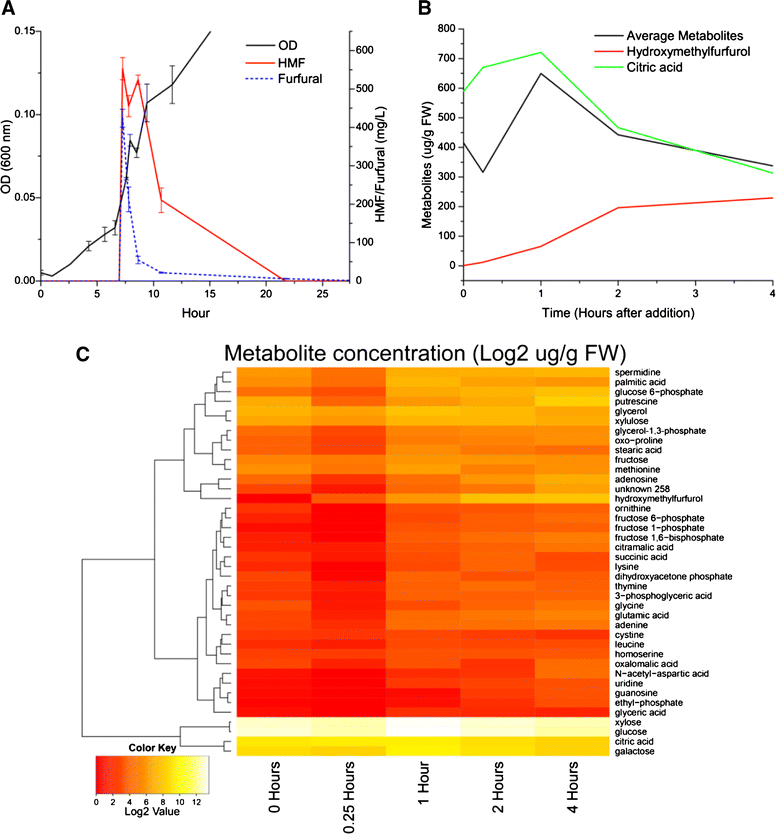Genome-scale resources for Thermoanaerobacterium saccharolyticum
- PMID: 26111937
- PMCID: PMC4518999
- DOI: 10.1186/s12918-015-0159-x
Genome-scale resources for Thermoanaerobacterium saccharolyticum
Abstract
Background: Thermoanaerobacterium saccharolyticum is a hemicellulose-degrading thermophilic anaerobe that was previously engineered to produce ethanol at high yield. A major project was undertaken to develop this organism into an industrial biocatalyst, but the lack of genome information and resources were recognized early on as a key limitation.
Results: Here we present a set of genome-scale resources to enable the systems level investigation and development of this potentially important industrial organism. Resources include a complete genome sequence for strain JW/SL-YS485, a genome-scale reconstruction of metabolism, tiled microarray data showing transcription units, mRNA expression data from 71 different growth conditions or timepoints and GC/MS-based metabolite analysis data from 42 different conditions or timepoints. Growth conditions include hemicellulose hydrolysate, the inhibitors HMF, furfural, diamide, and ethanol, as well as high levels of cellulose, xylose, cellobiose or maltodextrin. The genome consists of a 2.7 Mbp chromosome and a 110 Kbp megaplasmid. An active prophage was also detected, and the expression levels of CRISPR genes were observed to increase in association with those of the phage. Hemicellulose hydrolysate elicited a response of carbohydrate transport and catabolism genes, as well as poorly characterized genes suggesting a redox challenge. In some conditions, a time series of combined transcription and metabolite measurements were made to allow careful study of microbial physiology under process conditions. As a demonstration of the potential utility of the metabolic reconstruction, the OptKnock algorithm was used to predict a set of gene knockouts that maximize growth-coupled ethanol production. The predictions validated intuitive strain designs and matched previous experimental results.
Conclusion: These data will be a useful asset for efforts to develop T. saccharolyticum for efficient industrial production of biofuels. The resources presented herein may also be useful on a comparative basis for development of other lignocellulose degrading microbes, such as Clostridium thermocellum.
Figures







Similar articles
-
Nicotinamide cofactor ratios in engineered strains of Clostridium thermocellum and Thermoanaerobacterium saccharolyticum.FEMS Microbiol Lett. 2016 Jun;363(11):fnw091. doi: 10.1093/femsle/fnw091. Epub 2016 Apr 11. FEMS Microbiol Lett. 2016. PMID: 27190292
-
The bifunctional alcohol and aldehyde dehydrogenase gene, adhE, is necessary for ethanol production in Clostridium thermocellum and Thermoanaerobacterium saccharolyticum.J Bacteriol. 2015 Apr;197(8):1386-93. doi: 10.1128/JB.02450-14. Epub 2015 Feb 9. J Bacteriol. 2015. PMID: 25666131 Free PMC article.
-
Cofactor Specificity of the Bifunctional Alcohol and Aldehyde Dehydrogenase (AdhE) in Wild-Type and Mutant Clostridium thermocellum and Thermoanaerobacterium saccharolyticum.J Bacteriol. 2015 Aug 1;197(15):2610-9. doi: 10.1128/JB.00232-15. Epub 2015 May 26. J Bacteriol. 2015. PMID: 26013492 Free PMC article.
-
Microbial application of thermophilic Thermoanaerobacterium species in lignocellulosic biorefinery.Appl Microbiol Biotechnol. 2021 Aug;105(14-15):5739-5749. doi: 10.1007/s00253-021-11450-4. Epub 2021 Jul 20. Appl Microbiol Biotechnol. 2021. PMID: 34283269 Review.
-
Comparative genomics of the mesophilic cellulosome-producing Clostridium cellulovorans and its application to biofuel production via consolidated bioprocessing.Environ Technol. 2010 Jul-Aug;31(8-9):889-903. doi: 10.1080/09593330.2010.490856. Environ Technol. 2010. PMID: 20662379 Review.
Cited by
-
Conversion of phosphoenolpyruvate to pyruvate in Thermoanaerobacterium saccharolyticum.Metab Eng Commun. 2020 Jan 23;10:e00122. doi: 10.1016/j.mec.2020.e00122. eCollection 2020 Jun. Metab Eng Commun. 2020. PMID: 32025490 Free PMC article.
-
Strain and bioprocess improvement of a thermophilic anaerobe for the production of ethanol from wood.Biotechnol Biofuels. 2016 Jun 16;9:125. doi: 10.1186/s13068-016-0536-8. eCollection 2016. Biotechnol Biofuels. 2016. PMID: 27313661 Free PMC article.
-
The redox-sensing protein Rex modulates ethanol production in Thermoanaerobacterium saccharolyticum.PLoS One. 2018 Apr 5;13(4):e0195143. doi: 10.1371/journal.pone.0195143. eCollection 2018. PLoS One. 2018. PMID: 29621294 Free PMC article.
-
Integrated omics analyses reveal the details of metabolic adaptation of Clostridium thermocellum to lignocellulose-derived growth inhibitors released during the deconstruction of switchgrass.Biotechnol Biofuels. 2017 Jan 10;10:14. doi: 10.1186/s13068-016-0697-5. eCollection 2017. Biotechnol Biofuels. 2017. PMID: 28077967 Free PMC article.
-
Draft Genome Sequence of Thermophilic Bacillus sp. TYF-LIM-B05 Directly Producing Ethanol from Various Carbon Sources Including Lignocellulose.Curr Microbiol. 2020 Mar;77(3):491-499. doi: 10.1007/s00284-019-01833-2. Epub 2019 Dec 12. Curr Microbiol. 2020. PMID: 31832840
References
Publication types
MeSH terms
Substances
LinkOut - more resources
Full Text Sources
Other Literature Sources
Molecular Biology Databases
Research Materials
Miscellaneous

